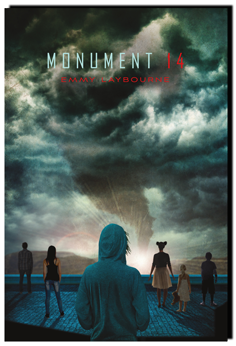Emmy Laybourne's Blog, page 11
February 4, 2012
Howard Suber’s secret weapon
Sometimes you can’t exactly see what it is you’ve created until you see it though other people’s eyes. It was the prolific comedian, culture commentator and writer, Kevin Maher who first clued me in to what my debut novel Monument 14 really is.
He asked me to do a reading from my novel in a show called “Genre-busters.” He told me he’d like me to talk about the juncture of Young Adult and Post-apocalyptic literature.
And then, ahem, I realized I had written an post-apocalyptic YA book. I don’t know why I didn’t realize it earlier. I wrote the thing! It took me over a year! But somehow I was just telling the story of what happens when fourteen kids get stranded in a super-store while civilization collapses outside. I knew I was writing for my favorite genre – YA, but I didn’t quite realize that I was also writing in my other favorite genre – post-apocalyptic.
Lucky for me, too, because nowadays, most successful fiction is biassociative. Biassociation is a concept I was introduced to at UCLA by Professor Howard Suber. In this example, it simply means a single unity that draws on the associations of two or more distinct categories or genres.
A film or novel could have a biassociative genre – here’s a really obvious one: Cowboys and Aliens! The two genres are right there in the title. Here’s a more subtle example: Romancing the Stone (Romance and action/adventure). A character can also be bi-associative. Often a hero in a story will belong to two groups. Think of Indiana Jones (anthropologist/treasure hunter), or Superman (mild-mannered reporter/superhero), or Lisbeth Salander (punk misfit/brilliant investigator).
Once you start looking for examples of biassociative works across genres or character types, you see them EVERYWHERE! (If you’d like to mention a few, just click on the title of this blog article to leave a comment. I’d LOVE to hear your examples.)
Professor Suber liked to point out the biassociative elements in all the big hit films we would discuss in class. He was continually asking us to measure our own works in terms of the biassociative criteria. Well, how does your won work hold up? Are you taking advantage of genre when you begin a new project?
January 17, 2012
Monument 14 Release Date: 06/05/12
Got a release date for my novel – MONUMENT 14 will be released Tuesday, June 5th. Why a Tuesday, you ask? I was curious too, so I poked around a bit. It turns out that most new books and CDs are released on Tuesdays.
Here is what some complete strangers thought about it:
 “To some extent, it makes sense for most things to be released on one day of the week. Bookstore and video managers know well in advance when new stuff is coming out and can plan displays accordingly. Thus, if the majority of new media comes out on Tuesday, they can spend Monday working out shelf space and displays without creating too much disruption for the rest of the week.” – someone with the screen name of MsRobyn
“To some extent, it makes sense for most things to be released on one day of the week. Bookstore and video managers know well in advance when new stuff is coming out and can plan displays accordingly. Thus, if the majority of new media comes out on Tuesday, they can spend Monday working out shelf space and displays without creating too much disruption for the rest of the week.” – someone with the screen name of MsRobyn
ChockFullOfHEadyGOodness wrote this: “For CDs, and previously for cassettes and LPs, Billboard compiles its sales chart data based on a Tueday-Monday week. Therefore releasing on Tuesday maximizes the number of copies sold in the first week of sales, and gives the highest possible chart position.
Don’ t know if something similar applies to books/DVDs/other media.”
Hmmm, I don’t know either, but I certainly appreciate your long, goofy screen name, ChockFullOfHeadyGoodness.
Whatever the reason, Tuesday, June 5th is the day and I guarantee you this: on Wednesday, June 6th I will have drunk too much champagne the night before.



